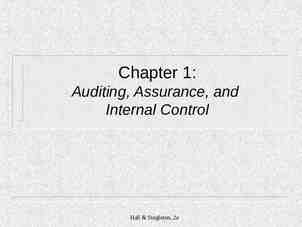10 Questionnaire Design
17 Slides81.67 KB
10 Questionnaire Design
Role of Questionnaire Survey research, by definition, relies on the use of a questionnaire. A questionnaire is a set of questions designed to generate the data necessary to accomplish the objectives of the research project; also called an interview schedule or survey instrument.
Role of Questionnaire Survey objectives Respondent info. Questionnaire Data analysis Findings Recommendations Managerial actions
Criteria for a Good Questionnaire Does it provide the necessary decision-making info./important insights for management? Does it consider the respondent? Does it poorly designed, confusing, or overly lengthy? Does it meet editing and coding requirements? – Editing: going through each questionnaire to ensure that skip patterns (sequence in which questions are asked, based on a respondent’s answer) were followed and the required questions filled out.
Questionnaire Design Process 1. Determine survey objectives, resources, and constraints 6. Evaluate the questionnai re 7. Obtain approval of all relevant parties 2. determine the datacollection method 5. Establish questionnai re flow and layout 8. Pretest and revise 3. Determine the question response format 4. Decide on question wording 9. Prepare final copy 10. Implement the survey
Questionnaire Design Process Step 1: Determine survey objectives, resources, and constraints – Survey objectives: outline of the decision-making info. sought through the questionnaire Step 2: Determine the data-collection method – Survey data can be gathered, in variety of ways (e.g. Internet, telephone, mail, mall, or self-administration) and the survey method impacts questionnaire design.
Questionnaire Design Process Step 3: Determine the question response format Three major types of questions are used in marketing research: 1. Open-ended questions: questions to which the respondent replies in her/his own words. 2. Closed-ended questions: questions that require the respondent to choose from a list of answers 3. Scaled-response questions: closed-ended questions in which the response choices are designed to capture the intensity of the respondent’s feeling.
Questionnaire Design Process 1. Open-ended questions: Ex: What do you think is most in need of improvement here at the airport? 2. Closed-ended questions: Dichotomous question (choose between 2 answers) Ex: Did you heat the Danish roll before serving? Yes 1 No 2 Multiple-choice question (choose among several answers) Ex: Please check the age group to which you belong. A. Under 17 1 D. 35-49 4 B. 17-24 2 E. 50-64 5 C. 25-34 3 F. 65 and over 6
Questionnaire Design Process 3. Scaled-response questions Ex: 4. Now that you have used the product, would you say that you would buy it or not? (CHECK ONE) Yes, would buy it No, would not buy it 2. Now that you have used the product, would you say that you (CHECK ONE) definitely would buy it probably would buy it might or might not buy it probably would not buy it definitely would not buy it
Questionnaire Design Process Step 4: Decide on the question wording Four guidelines about the wording of questions are useful to bear in mind: 1. Make sure the wording is clear 2. Avoid biasing the respondent 3. Consider the respondent’s ability to answer the questions 4. Consider the respondent’s willingness to answer the question
Questionnaire Design Process Step 5: Establish questionnaire flow and layout Guidelines concerning questionnaire flow: – Use screening questions to identify qualified respondents – Begin with a question that gets the respondent’s interest – Ask general questions first – Ask questions that require “work” in the middle – Position sensitive, threatening, and demographic questions at the end – Put instructions in capital letters – Use a proper introduction and closing
Questionnaire Design Process How a Questionnaire Should Be Organized Location Type Examples Rationale Screeners Qualifying questions “Have you been snow skiing in the past 12 months?” “Do you own a pair of skis” The goal is to identify target respondents. First few questions Warm-ups “What brand of skis do you own?” “How many years have you own them?” Easy-to-answer questions show the respondent that the survey is simple. First third of questions Transitions “What features do you like best about the skis?” Questions related to research objectives require slightly more effort. Second third Difficult and complicated questions “Following are 10 characteristics of snow skis. Please rate your skis on each characteristics, using the scale below.” The respondent has committed to completing the questionnaire. Last third Classifying and demographic conditions “What is the highest level of education you have attained?” The respondent may leave some “personal” questions blank, but they are at the end of the survey.
Questionnaire Design Process Step 5: Establish questionnaire flow and layout – A proper introduction and closing Example: Introduction/opening Hello, my name is ., and I’m calling from (company). Today/Tonight we are calling to gather opinions regarding (general subject), and are not selling anything. This study will take approximately (length) and may be monitored (and recorded) for quality purposes. We would appreciate your time. May I include your opinions? Closing Thank you for your time and cooperation. I hope this experience was a pleasant one. Please remember that your opinion counts! Have a good day/evening.
Questionnaire Design Process Step 6: Evaluate the questionnaire Issues should be considered: 1. For each question, is the question necessary? 2. Is the questionnaire too long? 3. Will the questions provide the info. needed to accomplish the research objectives?
Questionnaire Design Process Step 7: Obtain approval of all relevant parties – Example: for a new product questionnaire should get the approval from the new product development manager Step 8: Pretest with the target respondents and revise Step 9: Prepare final questionnaire copy – Include precise instructions: where to interview, target respondents, and when to respondents test items (if any) Step 10: Implement the survey
Impact of the Internet on Questionnaire Development For example, a marketing research company can now create a questionnaire and send it as an e-mail attachment to management for comments and approval; once approved, a programmed version can be placed on the research firm’s or client’s server to be administered an Internet survey.
Costs, Profitability, and Questionnaires The role of the questionnaire in survey research costs can be a decisive one. If a research firm overestimates data-collection costs, chances are that it will lose the project to another supplier. Most data-collection costs are associated not with conducting the actual interview, but with finding a qualified respondent (failed attempts, cooperation problems, screener determines respondent not eligible, or respondent terminated during interview).






















